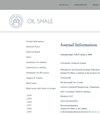利用烤箱和密封高压灭菌技术,用naoh-hcl法从两种海洋油页岩中分离有机物
IF 1.4
4区 工程技术
Q4 ENERGY & FUELS
引用次数: 4
摘要
采用NaOH-HCl、腐植酸和腐植酸分离馏分,从ElLajjun和Julia Creek两种海相油页岩中分离有机质。要将人灰分产量降低到11% db以下,需要两个处理。高压灭菌法的人类素产率为80 wt%的OM(无干矿物物质,dmmf),而烘箱法只有20-60 wt%的dmmf,可能是由于NaOH溶液强度的增加和一些氧化。无论产量如何,烘箱法和高压灭菌法都能得到与页岩有机质相似的化学结构。这种相似性对页岩有机质结构具有启示意义。本文章由计算机程序翻译,如有差异,请以英文原文为准。
ISOLATION OF ORGANIC MATTER BY THE NAOH-HCL METHOD FROM TWO MARINE OIL SHALES USING OVEN AND SEALED AUTOCLAVE TECHNIQUES
Organic matter (OM) was isolated from two marine oil shales, ElLajjun and Julia Creek, using NaOH-HCl and humin and humic acid fractions separated. Two treatments were required to reduce humin ash yield to below 11 wt% db. The humin yield of the autoclave method was 80 wt% of OM (dry mineral-matter-free, dmmf), compared to only 20–60 wt% dmmf for the oven method, possibly due to the increased NaOH solution strength and some oxidation. Oven and autoclave methods both gave humin similar in chemical structure to shale OM, regardless of yield. This similarity has implications as to shale OM structure.
求助全文
通过发布文献求助,成功后即可免费获取论文全文。
去求助
来源期刊

Oil Shale
工程技术-工程:石油
CiteScore
2.90
自引率
15.80%
发文量
14
审稿时长
4.2 months
期刊介绍:
The Oil Shale is a scientific-technical open access journal published by the Estonian Academy Publishers in collaboration with the University of Tartu, Tallinn University of Technology, and the Estonian University of Life Sciences.
 求助内容:
求助内容: 应助结果提醒方式:
应助结果提醒方式:


